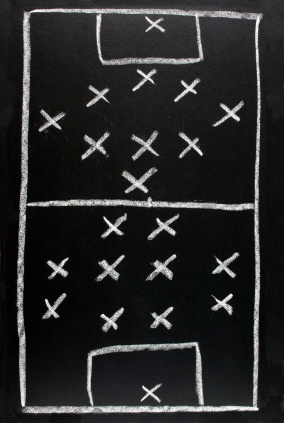Back in the early to mid 90’s, when I was loading up on coaching licenses and clinics, I was perusing through a second hand bookstore one day and came across a football training book called “Soccer: Guide to Training and Coaching”, by Allen Wade. The book was copyrighted in 1967. I thought it might be a bit outdated. But as I read on I found the book was originally published as “The F.A. Guide to Training and Coaching”. This piqued my interest.

Now one must understand that the U.S. built their football association, United States Soccer Federation, (USSF), around the principles of the FA. They could have used models from other countries, but I’m guessing because we spoke the same language and had so many expatriates living here, it probably made a lot of sense to use the FA as a model. Britons have also been key in the hands-on development of players here in the U.S. Many British trainers have come to the U.S. in search of fortune in the coaching profession. Some have done well and some have gone home or changed professions. But they have certainly (and still do) influenced our training methods and techniques.
So I purchased the book and found that Allen Wade was a former Director of Coaching for the FA. In general there were many parts of the book that were a bit dated. But the tactical portion was a gem. The formations used were different but the concepts were still the same. Compact defense, width in attack… In fact I pulled the book out and dusted it off in order to write this piece and in doing so realized that I need to give the book a going over again. But perhaps the jewel of the book was a piece on analyzing the game. Now contrary to what many football fans believe, watching a football (soccer) game and analyzing a football game are altogether two different things. Sometimes I watch a match as a fan. Then there are other times I have to switch into my coaching mode and view it from a much more analytical perspective. In general this is not as much fun but its certainly useful.
Sometimes when watching a match as a fan I find myself asking questions of why a particular problem is happening for a team. So I will for a short while start observing the game as a coach to analyze. For me it’s sort of like turning on or off a light switch. I know when I used to coach it was more or less second nature to observe a game and analyze. The light switch was always turned on. Nowadays it’s turned off more than on. But there is a different way of observing that does not follow the ball and doesn’t focus as much on the brilliant individual play but more the general tactical shapes of the two teams. One starts asking questions pertaining to where the attacks are coming from and who is influencing the game the most both in an attacking and defensive sense.
I believe your own experience also influences how closely we pay attention to the game. If you grew up with a high level of training as a youth player and experienced this for many years, you might very well find it second nature to read the game well. But I have heard stories of some great players who in their later years took coaching classes and ended up making comments like “if only I had understood these things when I was still a player”.
Even when I was coaching there were moments in games where the skill of a particular player or the flow of passing for a team would knock you sideways and you would end up like everyone else, dazed and amazed at that special moment in time when the game transcended everything and it was just this beauty. Then you would need to bring yourself back into the coaching mode and see what really happened. It can be extremely gratifying to analyze a game and then make adjustments to your team that make a difference in the outcome.
Tomorrow I will delve into the “how-to’s” of analyzing the game. But for now, here is a quote from the book regarding “reading the game”.
Reading the game is the ability to understand what is happening and as a consequence, to anticipate immediate or future developments. Some players appear to have a natural capacity for it while sometimes, even experienced player have only a shallow grasp of it, probably because, in their formative years, they were merely told what to do and not why is should be done. Until a player can read a game he cannot play an authoritative part, in the widest sense, in directing its course. All players should, therefore, strive to develop their ability to read the game. An analysis of a game must be methodical to be accurate.

 Clap
Clap